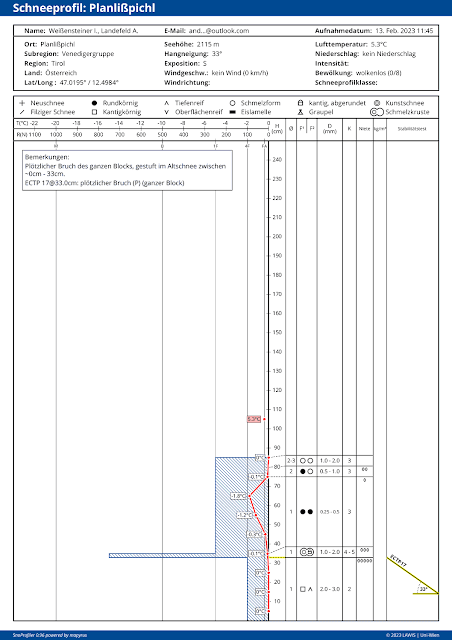To sum it up: Danger zones especially in little-tracked shady very steep terrain
During the last few days, Avalanche Headquarters Tirol received only isolated reports of avalanches involving persons (no injuries). Moreover, most snowpack analysis in the interim demonstrates a lack of tension inside the snowpack. Thus, we can assume there are only limited avalanche prone locations in open terrain where slab avalanches can now be triggered, particularly in shady, very steep terrain which has been not much tracked over the winter. On sunny slopes we assume very isolated danger zones for dry-snow slab avalanches around 2500m altitude.
On sunny slopes: high caution if they are wet
In the last few days avalanche danger levels increased slightly. In extremely steep sunny terrain we observed isolated moist loose-snow slides. On steep grass-covered slopes, somewhat more frequent glide-snow slides and small glide-snow avalanches occurred.
.jpg) |
| Red arrows point to recent loose-snow slides. Blue ellipse encircles a glide-snow slide, the magenta ellipse a slab avalanche about 10 days prior. Western Tux Alps. (photo: Hubert Gogl, 15.02.2023) |
.jpg) |
| Glide-cracks in eastern Lechtal Alps (photo: 15.02.2023) |
Firn snow
Following nights of clear skies, a melt-freeze crust capable of bearing loads forms on very steep sunny slopes, especially at intermediate altitudes. Due to the dry air, this is slower to soften up during the daytime. If you planned your time carefully, pure firn-snow enjoyments awaited. Weather conditions will now become less stable, firn snow will be found more seldom.
.jpg) |
| Descent through firn snow in eastern Lechtal Alps (photo: 15.02.2023) |
Knobby powder on shady slopes
Away from sunny slopes in a few wind-impacted zones you can find a loosely-packed, roughed-up snowpack surface. We refer to this as “knobby powder” which is excellent to ski through. (Caution: sharks are a threat - rocks just beneath the surface.)
.jpg) |
| In knobby powder your ski turns are more elegant. (photo: 12.02.2023) |
Weather development
According to Geosphere Austria (formerly ZAMG), conditions are becoming more variable, the air masses more moist. Nocturnal longwave outgoing radiation will decrease. Due to more shade during the daytime hours there will also be less energy penetrating the snowpack, unless there is more sunshine than expected. In that case, due to heightened air moisture and solar radiation more energy can penetrate the snow cover. For that reason, it’s important to keep your eye on the degree to which the snowpack becomes moist or wet, since if water seeps for the first time down to the often encrusted layer of faceted crystals at about mid-level in the snowpack, it will lead to more loss of firmness and heightened likelihood of slab avalanches triggering. The process is accelerated by the shallowness of the snowpack for this juncture of the season.
Additional information
 |
| Still too little snow for this juncture of the season. Top graph: maxima and minima to date, and middle value since 1960. Magenta: this winter |
 |
| Last week’s weather: brief period of gray skies starting Saturday, 11.02 afternoon; otherwise generally splendid wintery weather. Temperatures dropping slightly. |
